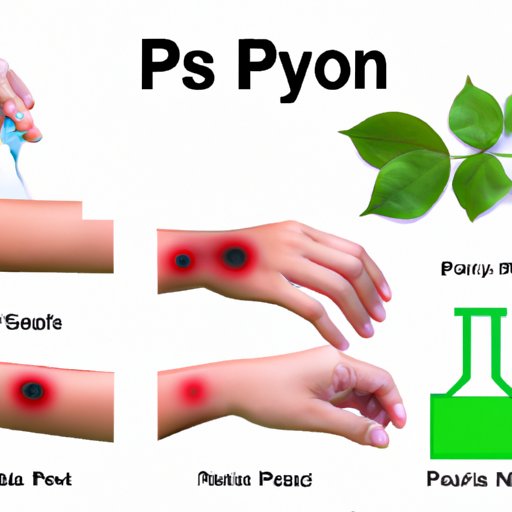Introduction
Have you recently suffered from a rash caused by poison ivy? This unpleasant and itchy condition can cause discomfort for days, or even weeks, and some people may wonder how long it will take for the rash to subside. This article will explore how long it takes for poison ivy to go away, as well as offer information on prevention, home remedies, medical treatments, and personal experiences related to the rash.
Causes and Symptoms of Poison Ivy Rash
Before we dive into how long it takes poison ivy to go away, it’s critical to understand what it is and how it causes a rash. Poison ivy is a plant commonly found in North America that contains an oily resin called urushiol. When this resin comes in contact with the skin, it can cause a rash, blisters, and itching. The rash typically appears within one to three days after contact with the plant. It’s important to note that poison ivy can also spread from contact with items that have come in contact with the plant, such as clothing or tools.
The symptoms of poison ivy rash may vary from person to person, but typically include redness, swelling, blisters, and intense itching. The blisters may be small or large, and they may ooze clear yellow fluid. The rash may also feel warm to the touch and may become more severe over time if left untreated.
Duration of Poison Ivy Rash
The duration of poison ivy rash can vary depending on a few factors. For most people, the rash will go away on its own within one to three weeks. However, in some cases, the rash may take longer to subside, lasting up to six weeks or more. The duration of the rash may be affected by the severity of the reaction, the amount of urushiol exposure, and the effectiveness of any treatments used.
There are a few things you can do to help speed up the healing process of poison ivy rash. First and foremost, it is important to avoid scratching or touching the affected area, as this can spread the rash or cause an infection. You can use over-the-counter creams or lotions to help soothe the itching and provide relief. Some people find that cool compresses or oatmeal baths can also help alleviate the symptoms of poison ivy rash.
Home Remedies for Poison Ivy
There are several popular home remedies for poison ivy rash that have been used for generations. One of the most common remedies is to use jewelweed, which is a plant that grows in the same areas as poison ivy. To use jewelweed, you can crush the plant’s stems and leaves and apply the juice to the affected area. Other home remedies include applying a paste made from baking soda and water, taking an oatmeal bath, or using aloe vera gel.
If you are using a home remedy for poison ivy rash, it’s essential to follow the proper application instructions. Applying too much of a remedy or using it too frequently could irritate the skin further and prolong the duration of the rash.
Medical Treatments for Poison Ivy
If your poison ivy rash is severe or does not go away on its own, it may be necessary to seek medical attention. Your doctor may prescribe a corticosteroid cream or oral medication to help reduce inflammation and itching. Severe cases of poison ivy rash may require a steroid shot or hospitalization in rare cases.
It is important to note that some people may be more susceptible to a severe reaction to poison ivy. Those with weakened immune systems, such as people undergoing chemotherapy, or those with severe allergies may require more aggressive treatment for the rash.
Prevention of Poison Ivy Rash
The best way to prevent a poison ivy rash is to avoid contact with the plant in the first place. This means learning how to identify poison ivy and taking precautions when in areas where the plant may be present, such as wearing long pants and sleeves and using gloves when gardening or hiking. If you do come in contact with poison ivy, it’s essential to wash the affected area thoroughly with soap and water within 10 minutes to remove any urushiol.
Understanding Poison Ivy and Its Effects
While poison ivy may be a common nuisance for many, it’s essential to understand the science behind the plant and why some people may be more susceptible to a severe reaction. Some studies have shown that the severity of an individual’s reaction to poison ivy may be related to their genetics or immune system. In general, people who have had a reaction to poison ivy in the past may be more likely to develop a rash in the future.
Personal Experiences with Poison Ivy Rash
Many people have dealt with poison ivy rash at some point in their lives, and it can be helpful to hear their stories and learn from their experiences. Some may offer advice on how to ease the itching, while others may share their strategies for avoiding contact with the plant in the future.
Conclusion
Overall, poison ivy rash can be an unpleasant condition that lasts for several weeks. While most people will see the rash subside on its own, it’s essential to take proper precautions to avoid contact with the plant and practice good hygiene if you do come in contact with it. If the rash is severe or doesn’t go away on its own, seeking medical attention may be necessary. Remember, it’s always best to err on the side of caution when dealing with poison ivy to ensure a quick and painless recovery.
